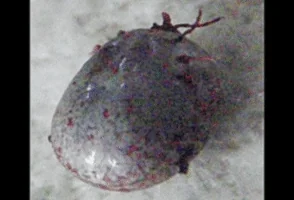Lyme
disease bacteria eradicated by new
drug in early tests
Kris
Newby. published In SCOPE, by the Stanford University School of
Medicine
 In 2002, my husband
and I became seriously ill after a vacation to Martha's Vineyard. It took ten
doctors and a year to discover the root cause:
In 2002, my husband
and I became seriously ill after a vacation to Martha's Vineyard. It took ten
doctors and a year to discover the root cause: We'd been bitten by unseen ticks harboring the parasites that cause Lyme disease and babesiosis, a malaria-like disease.
Our road to recovery
was grueling, requiring five years of intermittent antimicrobial treatments.
Later, I discover that my situation wasn't all that uncommon. About one in five Lyme patients continue to suffer from ongoing symptoms after being treated with the recommended course of antibiotics. After that experience, it was abundantly clear that we need better treatments.
Later, I discover that my situation wasn't all that uncommon. About one in five Lyme patients continue to suffer from ongoing symptoms after being treated with the recommended course of antibiotics. After that experience, it was abundantly clear that we need better treatments.
That's why I was
excited to hear about a study from Stanford Medicine researchers
and their collaborators that provides evidence that the drug azlocillin
eliminates the bacteria that cause Lyme disease at the onset of infection in
lab mice and cultures.
Lyme disease, the most
common vector-borne disease in the United States, affects more than 300,000
people a year. It is caused by the bacterium Borrelia
burgdorferi, which is transmitted to humans through the bite of infected
blacklegged ticks.
If the disease isn't treated promptly, it can lead to life-threatening heart issues and chronic neurological problems. Common persistent Lyme symptoms include fatigue, joint pain, muscle pain, numbness, tingling, burning pains, and changes in mood, memory or mental clarity.
If the disease isn't treated promptly, it can lead to life-threatening heart issues and chronic neurological problems. Common persistent Lyme symptoms include fatigue, joint pain, muscle pain, numbness, tingling, burning pains, and changes in mood, memory or mental clarity.
Standard treatment of
Lyme disease is oral antibiotics, typically doxycycline, in the early stages of
the disease; but for reasons that are unclear, the antibiotics don't work for
up to 20% of people with the tick-borne illness. One possibility is that
drug-tolerant bacteria cause the lingering symptoms.
This drug study, published online in Scientific Reports, was conducted by a team led by Jayakumar Rajadas, PhD, assistant professor of medicine and director of Stanford's Biomaterials and Advanced Drug Delivery Laboratory, and research associate Venkata Raveendra Pothineni, PhD.
The team zeroed in on
azlocillin as a promising drug candidate through the use of high throughput
drug screening. This process entails acquiring "libraries" of
thousands of known chemical compounds and drugs, then mixing Lyme bacteria with
each in tiny wells to see which ones are best at killing the organisms.
The best drug candidates were retested in larger culture dishes, then the safest of these were tested in vivo in seven mice.
The best drug candidates were retested in larger culture dishes, then the safest of these were tested in vivo in seven mice.
 |
| This image shows how the Lyme bacteria, Borrelia burgdorferi, form protective round body "persisters" when threatened by defensive immune system biochemicals in blood serum. |
This drug is currently being evaluated in a clinical trial with previously-treated Lyme patients. The trial coordinators are still looking for volunteers.
According to the
recent study, azlocillin shows promise because it appears to be able to kill
the two morphological forms of the Lyme bacteria -- the actively replicating
spiral forms and the semi-dormant round-body forms.
Azlocillin also
appears to kill drug-tolerant persisters very effectively. These protective
persisters form when the bacteria are threatened with defensive immune system
biochemicals or antibiotics.
After the threat has passed, the bacteria can reemerge to cause active disease. Many researchers believe that doxycyline's inability to clear the persisters may account for the ongoing symptoms of some Lyme sufferers.
After the threat has passed, the bacteria can reemerge to cause active disease. Many researchers believe that doxycyline's inability to clear the persisters may account for the ongoing symptoms of some Lyme sufferers.
Although azlocillin is
an FDA-approved drug, more research needs to be done before it is used to treat
Lyme patients. Rajadas and Pothineni have patented the compound for the
treatment of Lyme disease and are working with a company to develop an oral
form of the drug. Researchers plan to conduct a clinical trial.
As Pothineni said in
the Stanford Medicine news release:
"We have been screening potential drugs for six years ... We've screened almost 8,000 chemical compounds. We have tested 50 molecules in the dish. The most effective and safest molecules were tested in animal models. Along the way, I've met many people suffering with this horrible, lingering disease. Our main goal is to find the best compound for treating patients and stop this disease."
A former science writer
with Stanford Medicine, Kris Newby is the author of Bitten: The
Secret History of Lyme Disease and Biological Weapons. She is
now working on a documentary based on the book.